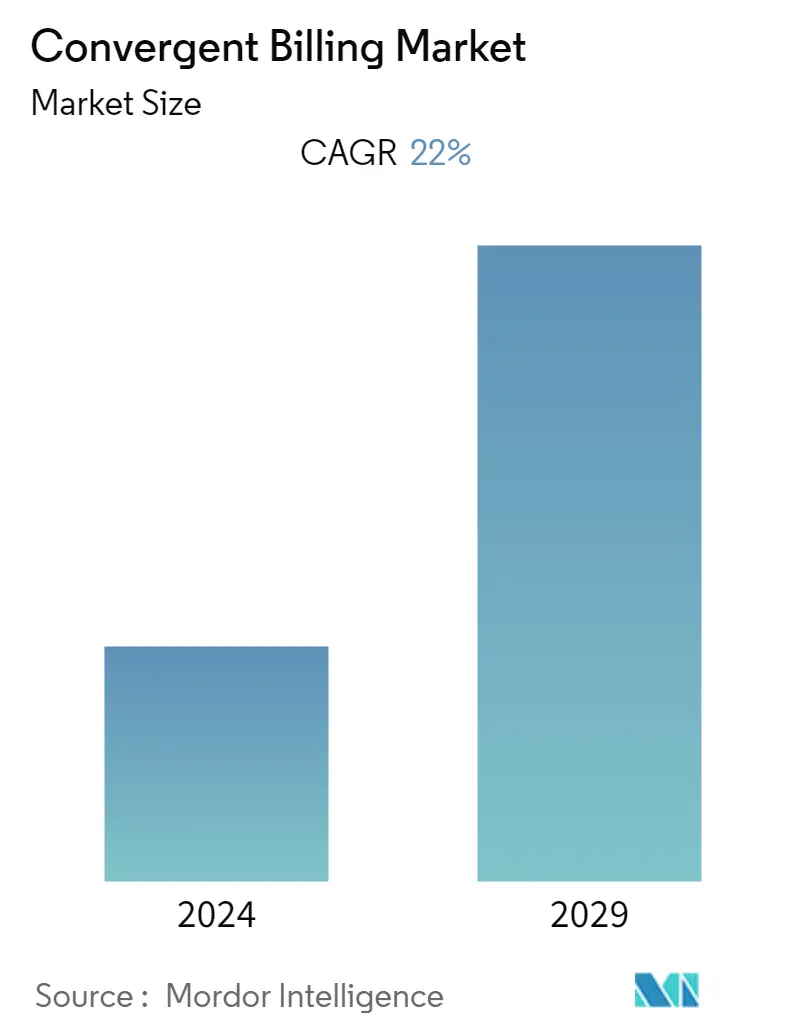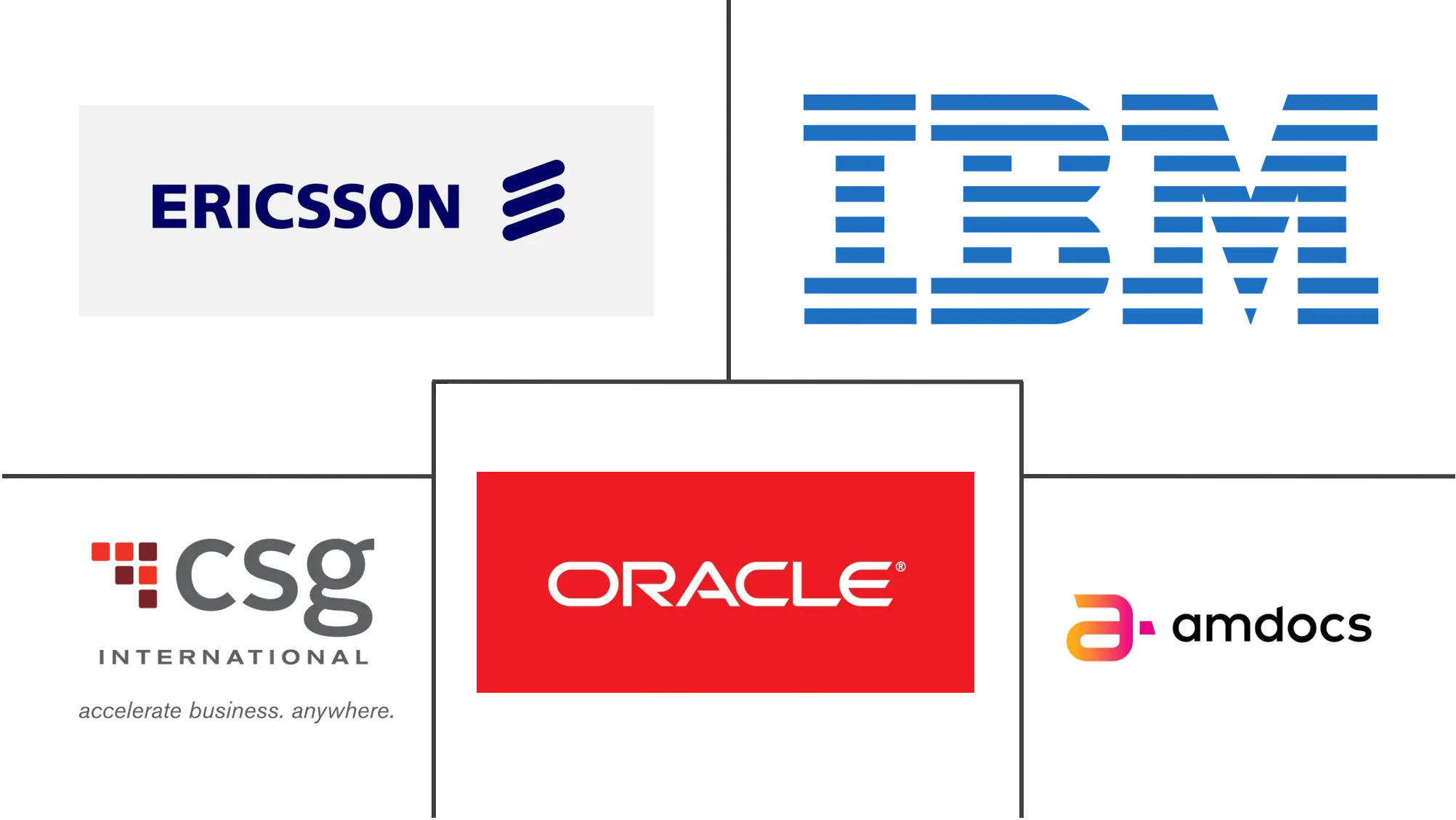Market Size of Convergent Billing Industry

| Study Period | 2019 - 2029 |
| Base Year For Estimation | 2023 |
| CAGR | 22.00 % |
| Fastest Growing Market | Asia Pacific |
| Largest Market | North America |
| Market Concentration | Medium |
Major Players
*Disclaimer: Major Players sorted in no particular order |
Convergent Billing Market Analysis
The Convergent Billing Market is expected to register a CAGR of approximately 22% during the forecast period (2020 - 2025). Telecom companies are increasingly embracing digitization in their business environment and are launching innovative services based on IoT, often in collaboration with partners worldwide. Owing to such growing trends, telecom billing systems evolved to play a critical role in facilitating new services based on customer needs and efficient monetization.
- Convergent billing provides an efficient method to consolidate all billing tasks and leads to enhanced transparency in the billing process. It provides a holistic view of the customer in real-time, which helps create bundling and discounting services, keeping the customers in mind.
- With the increasing technological integration, the complexity of the new service architecture is increasing, due to which the telcos are facing several challenges, such as rapidly dwindling revenues. Hence, the telcos are increasingly focusing on bundled offerings, flexible discounting rules, cross-sell campaigns, and hassle-free customer experience. Hence, the adoption of convergent billing systems increases, as it provides a single-window solution for an operator's billing requirements and a corporate or enterprises' bundled offerings.
- With the rollouts of 5G technology globally, the need for convergent billing solutions is increasing, further creating ample opportunities for solution providers to gain market traction. For instance, Huawei recently launched Convergent Billing System (CBS) R20, which was declared the industry's first-ever 5G SA network-based monetization solution in London. The solution has already been deployed over the stc Kuwait 5G SA's network, whereas the 'Dedicated Access' was offered to enterprises with guaranteed Service Level Agreements (SLAs).
- The COVID-19 crisis had a positive impact on the growth of a few sectors, including IT and telecommunications. The demand for digital services especially has escalated at a high rate in past few months. Nevertheless, the decrease in business activities and manual business operations such as partnerships lead to boost the adoption of convergent billing solutions.
Convergent Billing Industry Segmentation
A convergent billing system is the integration of various service charges in a single customer invoice by creating a unified view of the customer. It provides a high-capacity, flexible, and scalable service-agnostic telecom billing data management system, which enables the service providers to monetize services ranging from traditional telecommunications through MVNO and IoT to modern digital services.
| Component | |
| Solution | |
| Services |
| Deployment | |
| On-Cloud | |
| On-Premise |
| Solutions | |
| Bill Cycle Optimization | |
| Billing Account Management | |
| Automated Invoice and Bill Generation | |
| Payment and Collection | |
| Customer Relationship Management |
| Geography | |
| North America | |
| Europe | |
| Asia Pacific | |
| Latin America | |
| Middle East and Africa |
Convergent Billing Market Size Summary
The Convergent Billing System market is experiencing significant growth, driven by the increasing digitization efforts within telecom companies and the launch of innovative IoT-based services. This evolution has positioned telecom billing systems as essential tools for facilitating new services tailored to customer needs and optimizing revenue streams. Convergent billing systems offer a comprehensive solution by consolidating all billing tasks, enhancing transparency, and providing a real-time holistic view of customers. This capability supports the creation of bundled offerings and flexible discounting strategies, addressing the challenges posed by complex service architectures and declining revenues. The global rollout of 5G technology further amplifies the demand for these solutions, presenting ample opportunities for providers to expand their market presence.
The adoption of cloud-based models and micro-services architecture is transforming the convergent billing landscape, offering flexibility and high performance. These advancements enable telecom operators to maintain differentiated service capabilities with minimal infrastructure. The integration of billing and CRM systems, along with the use of PaaS for asynchronous processing, is enhancing customer acquisition and retention efforts. The North American region is poised to lead the market due to its technological advancements and increasing demand for connected devices. The competitive landscape is becoming fragmented, with numerous players innovating and collaborating to drive adoption. Notable developments include SAP's UX enhancements and strategic partnerships by companies like Tridens, highlighting the dynamic nature of the market.
Convergent Billing Market Size - Table of Contents
-
1. MARKET DYNAMICS
-
1.1 Market Overview
-
1.2 Market Drivers
-
1.2.1 Digitization of the Telecom Sector
-
1.2.2 Increasing Complexity of New Service Architecture and Increasing Demand for Unified Services
-
1.2.3 Increasing Focus on Customer Satisfaction
-
-
1.3 Market Restraints
-
1.3.1 The Inclination Towards Traditional Billing Systems
-
-
1.4 Industry Attractiveness - Porter's Five Forces Analysis
-
1.4.1 Bargaining Power of Suppliers
-
1.4.2 Bargaining Power of Buyers/Consumers
-
1.4.3 Threat of New Entrants
-
1.4.4 Threat of Substitute Products
-
1.4.5 Intensity of Competitive Rivalry
-
-
1.5 Assessment of Impact of Covid-19 on the Market
-
-
2. MARKET SEGMENTATION
-
2.1 Component
-
2.1.1 Solution
-
2.1.2 Services
-
-
2.2 Deployment
-
2.2.1 On-Cloud
-
2.2.2 On-Premise
-
-
2.3 Solutions
-
2.3.1 Bill Cycle Optimization
-
2.3.2 Billing Account Management
-
2.3.3 Automated Invoice and Bill Generation
-
2.3.4 Payment and Collection
-
2.3.5 Customer Relationship Management
-
-
2.4 Geography
-
2.4.1 North America
-
2.4.2 Europe
-
2.4.3 Asia Pacific
-
2.4.4 Latin America
-
2.4.5 Middle East and Africa
-
-
Convergent Billing Market Size FAQs
What is the current Convergent Billing Market size?
The Convergent Billing Market is projected to register a CAGR of 22% during the forecast period (2024-2029)
Who are the key players in Convergent Billing Market?
IBM Corporation, Amdocs, Inc., Oracle Corporation, CSG Systems International, Inc. and Telefonaktiebolaget LM Ericsson are the major companies operating in the Convergent Billing Market.

